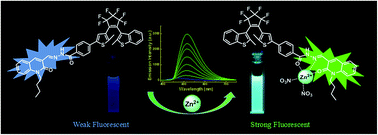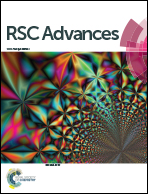A highly selective and sensitive fluorescent chemosensor for Zn2+ based on a diarylethene derivative†
Abstract
A promising photochromic fluorescent chemosensor 1o linked with Schiff base unit was synthesized. It displayed outstanding photochromism and a superb fluorescence turn-on response toward Zn2+. Upon the addition of Zn2+ to 1o, the fluorescent color of the solution obviously changed from blue to bright green with a 27-fold fluorescent intensity increase. The combination of 1o–Zn2+ with 1 : 1 stoichiometry was verified by Job's plot and MS analysis. The detection limit for 1o toward Zn2+ was measured to be 8.10 × 10−8 M. Furthermore, logic gate research was established with Zn2+, UV and visible light as input signals and the emission intensity as the output signal.



 Please wait while we load your content...
Please wait while we load your content...